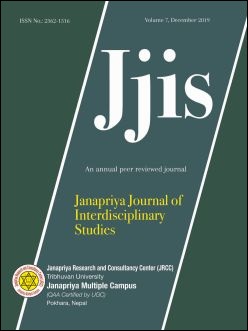Factors Associated with Children Ever Born among Lower Caste Women in Some Selected Wards of Pokhara, Nepal
DOI:
https://doi.org/10.3126/jjis.v7i1.23054Keywords:
Children ever born, contraception, lower caste, marriage, Nepal, womenAbstract
Fertility is the main components of population growth. Children ever born vary in different sub groups of the same population in terms of age at marriage, age of women, literacy, occupation, contraception user and mass media exposure. The objective of this study is to find out association between children ever born and selected socio-demographic characteristics in lower caste women. A descriptive study was conducted in some selected wards of Pokhara, Nepal during April 2018. Five wards were selected randomly out of 33 wards and 187 lower caste women were selected using convenience sampling technique. The data was collected by using semi-structured interview schedule. Chi-square test was applied to find out association between children ever born and selected socio-demographic characteristics.Higher children ever born were concentrated in the age at marriage from 21 to 25 as compared to other groups of age at marriage. Practice of contraceptive use is low among lower caste people although 66.31% lower caste women were exposed to mass media. The result shows that the factors age at marriage, contraceptive use and mass media exposure were highly associated with children ever born among lower caste women under study (P<0.05). Education on fertility is more powerful than urban residence. Concern authorities should play vital role to increase education level among lower caste people for increasing age at marriage, contraceptive use and practice of family planning to reduce children ever born.




